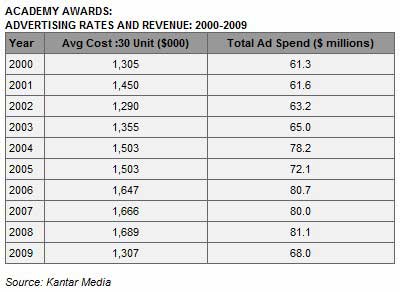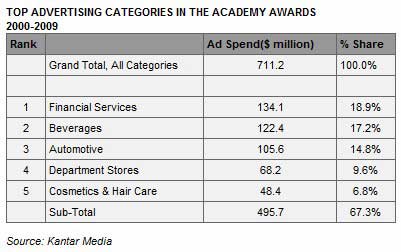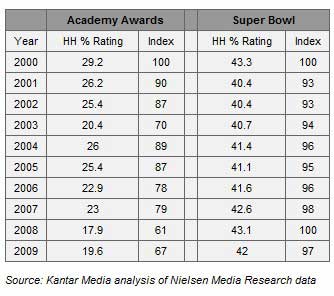Over the past 10 years (2000-2009), the Academy Awards ceremony has generated $711.2 million of advertising revenue, of which one-half (50.9%) has come from three industries—financial services, beverages, and automotive—according to Kantar Media.
Sometimes referred to in advertising circles as "the Super Bowl for women," the Academy Awards remains a marquee franchise for advertisers, even though TV audience ratings have declined in recent years.
Below, additional findings released by Kantar.
The Price of Advertising Over 10 Years
After three consecutive years of stable ad prices and revenue, the average cost of a 30-second ad during the Academy Awards fell 22.6% in 2009, to $1.31 million, from $1.69 million the previous year.

Total ad revenue for the year fell 16.2%, to $68.0 million, from $81.1 million the previous year. That performance was influenced by two factors, including a deepening recession that caused marketers to slash their ad budgets, and the prospect of an actor's strike that threatened to damage TV ratings. Though the strike threat was resolved a month before the event, the deteriorating economy proved less surmountable.
Over the past 10 years, the top 5 ad categories accounted for 67.3% of total Academy Awards ad revenue, led by the financial services (18.9%), followed by beverages (17.2%), automotive (14.8%), department stores (9.6%), and cosmetics & hair care (6.8%).

The 2009 Awards ceremony featured the first-ever advertising from movie studios, after the Academy removed a long-standing ban. Disney and Paramount each bought one spot to plug an upcoming theatrical release.
Ceremony's Top Advertisers Shift in 2009
Throughout much of the past decade, the Academy Awards has had a stable core of blue-chip advertisers that accounted for a majority of ad revenue, including companies such as General Motors, L'Oreal, American Express, and JC Penney.
However, in 2009, GM and L'Oreal dropped out completely in cost-cutting moves. Other marketers eventually stepped in, but the top advertiser rankings underwent a major reshuffling with Hyundai at the top of the 2009 leaderboard in its Academy Awards debut.

Prior to the withdrawal of GM and L'Oreal, the last big shake-up occurred in 2006 when Coca-Cola took over the beverage category sponsorship from Pepsi.
Looking for real, hard data that can help you match social media tools and tactics to your marketing goals? The State of Social Media Marketing, a 240-page original research report from MarketingProfs, gives you the inside scoop on how 5,140 marketing pros are using social media to create winning campaigns, measure ROI, and reach audiences in new and exciting ways.
First-Time Advertisers Increase in 2009
Historically, the low turnover rate among major sponsors—coupled with stiff limits on the total amount of commercial inventory in the broadcast—has made it difficult for new marketers to gain entrance into the program.
However, the Awards ceremony went against the norm in 2009 as the weak economy drove some major sponsors to withdraw, creating a rare opportunity for other companies to buy in: 33% of advertisers in 2009 were first-timers, the highest level since 2002.
Advertising newcomers in 2009 included Bristol-Myers Squib, Hyundai, Sprint Nextel, Techtronics (Hoover Appliances), Viacom, and Whirlpool.
Less Ad Clutter in Academy Awards
The Academy Awards program stands out for the uncluttered environment it offers marketers: The total volume of network ad time in the 3+ hour-long broadcast has averaged 32 minutes over the past 10 years, including paid ads plus promotional plugs from the network for its own programming.
On an hourly basis, advertising accounts for 8-10 minutes of air time each hour during the Awards program, compared with 13-14 minutes for the Super Bowl and 14-16 minutes for a typical hour of primetime network programming.
TV Ratings for Academy Awards Trending Downward
Audience ratings for the 2009 Academy Awards program finished with a 19.6/67 household rating, up from 17.9/61 in the previous year, but still the third lowest-rated broadcast in its televised history.

Over the past decade, household ratings have plummeted 33%, compared with Super Bowl ratings, which have fallen less than 5% over the same period.
The Academy's decision to expand the best picture category to 10 nominations, and to promote the upcoming ceremony via social media, including on Facebook and YouTube, reflect an effort to broaden audience appeal.
The 82nd Annual Academy Awards will be televised live on Sunday, March 7, by ABC, and will air live in more than 200 countries.
About the data: The 10-year advertising data was compiled by Kantar Media from its database. TV ratings information is provided by the Nielsen Company.



